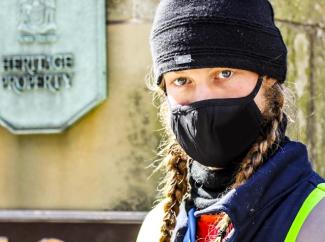DR. BOSS
Alberta bosses to decide who can work while infected with COVID-19

WHO NEEDS DOCTORS WHEN YOU’VE GOT BOSSES? That is the guiding principle behind a new Alberta public health order that gives employers near unquestioned authority to decide when workers infected with COVID-19 still need to come into work.
The “critical worker exception” order lets employers be the primary judge of both:
-
whether the service they provide is critical, and then
-
which of their COVID-positive employees are essential.
Alberta Health Services says its new ‘critical worker exception’ order is necessary to ease critical labour shortages, in sectors such as health care, caused by the Omicron variant.
‘Unique in its stupidity’
“This order is unique in its stupidity, and unique in terms of its just sheer disregard for workers’ rights,” said Ubaka Ogbogu, an associate professor in the faculty of at the University of Alberta.
Chief Medical Officer of Health Dr. Deena Hinshaw, the one-time COVID-19 popular hero, signed the order giving bosses this extraordinary power. There is no application process for the exemption, and return-to-work plans will not be reviewed by any government department.
“What’s really scary is that it’s the employer who determines if they have met the standard,” Ogbogu said. “There is no process.”
“I can see it being used by a variety of industries that are not necessarily essential.”
The order is not designed to protect public health, but to insulate industry from the impacts of the pandemic, Ogbogu said.
Must trust the bosses
Alberta health places great faith in employers to avoid the temptation to misuse their new-found power over their workers.
In a statement, Alberta Health spokesperson Christa Jubinville said the decision to bring infected workers back should only be made as a last resort to maintain services which, if disrupted, might endanger the public.
“The workers and worksites to whom this exception may apply are very limited,” she said.
To qualify for a critical worker exemption, a worker must: be part of a service of which a disruption would be harmful to the public, and, be determined by the owner or operator to be needed in-person for duties that are essential to the continued safe operations of the service.
Managers must also develop a safety plan to minimize the risk posed by COVID-positive employees.
The order also details a “risk hierarchy” for determining which workers should be called in. It states that preference should be given to workers who have three doses of vaccine, with unvaccinated workers being selected last.
Jubinville said there will be no targeted inspections but infractions may be noted if the businesses are inspected for other purposes and followed up on as required.
‘Wild west’ approach
Lorian Hardcastle, an associate professor in the faculty of law at the University of Calgary, said more oversight is needed to ensure workplace safety is maintained.
“I’m confused as to how the government took evidence that the infectious period can be shorter to mean that there’s no infectious period at all,” said Hardcastle.
The province should have also created an exhaustive list of which operators qualify and established an application process to ensure each worksite safety plan is reviewed by the chief medical officer of health, Hardcastle said.
Inspections should be mandatory, she added.
“Both of those things would have helped satisfy the concern that it’s going to be a bit of a Wild West in terms of which businesses decide that they qualify.”
- 30 -













Add new comment